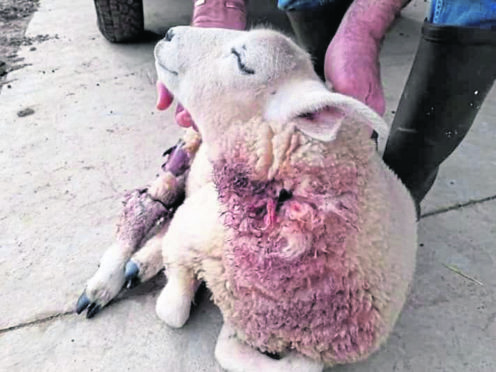Recent sheep-worrying incidents in the Highlands have sparked angry reactions from campaigners trying to get owners to keep their dogs on leads in the countryside.
In the most recent attack, four sheep belonging to Joan and David MacQueen of Dalmagarry Farm, Moy, were savaged just a few days ago.
Local councillor Duncan MacPherson said he was horrified by the extent of the injuries sustained by the lambs.
He said: “This is a direct result of irresponsible dog owners allowing their dogs to run free in the countryside and subsequently brutally attacking defenceless sheep.
“Taking care of livestock is demanding enough in our challenging Highland climate without these shocking events for Inverness-shire farmers to have to contend with.
“I hope Highland Council and Northern Police will send out a strong message to irresponsible dog owners of the severe consequences of their behaviour in ignoring the Country Code.”
In May, 12 rare breed sheep were savaged to death in Ardgay after farmers in the area complained of stray and loose dogs at large.
In August, a lamb was killed by a dog at Croila Croft near Kingussie, and in September, three pet lambs suffered horrific injuries at Ashton farm, Inverness, while the rest of the terrified flock scattered with several sustaining severe injuries in the panic.
>> Keep up to date with the latest news with The P&J newsletter
MSP Kate Forbes called those who don’t put their dog on a lead when near livestock ‘thoughtless, selfish and foolish.’
She said: “I am deeply concerned by the recent reports of sheep worrying in the Aviemore and Strathdearn areas.
“There is really no excuse and it is nothing short of disgraceful that these warnings still need to be issued every year.”
Police Scotland warned that the mere presence of a dog in a field of sheep could cause significant damage.
A Police Scotland spokesman said: “The worrying of livestock can have devastating consequences for farm animals and has an obvious financial and emotional impact on farmers and their businesses.
“The advice to dog owners who live in rural areas or anyone walking and exercising their dogs in the countryside is to ensure they are under control at all times and avoid going into fields where livestock is grazing.
“The Scottish Outdoor Access Code says dogs shouldn’t be taken into fields where there are lambs or other young farm animals.”
Insurer NFU Mutual says sheep-worrying cost Scottish farmers £330,000 last year with incidents rising by 67% in the past two years.
NFU Scotland Policy Manager Gemma Cooper said the 2010 Dog Control Act has failed to reduce the number of out of control dogs.
She said: “The real reason for this is that Dog Control Notices, the main mechanism for control under this Act, remain chronically under used by the vast majority of local authorities in Scotland.”
Highland Council has a statutory duty to investigate and record reports of dogs being out of control.
In 2017 the council served 20 Dog Control Notices (DCN), two of them for dogs attacking livestock, one in Nairn and one in Torlundy.
A Highland Council spokeswoman said: “The council can serve a DCN to place conditions upon the owner to keep the dog under control to ensure the safety of other people and animals by preventing further incidents.
“Typical measures that may be included in a DCN are keeping the dog on a lead in public, muzzling the dog in public, attending suitable dog training courses.”










